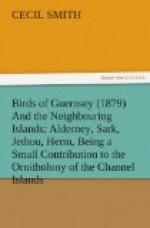My thanks are also due to Col. L’Estrange for the assistance he has given me in egg-hunting, and also to Captain Hubback for his notes from Alderney during the times he was quartered there.
BIRDS OF GUERNSEY.
1. White-tailed Eagle. Haliaeetus albicilla, Linnsaeus. French, “Aigle pygarque,” “Pygarque ordinaire.”—The White-tailed Eagle is an occasional but by no means uncommon visitant to all the Islands. I have seen specimens from Alderney, Guernsey, and Herm, and have heard of its having been killed in Sark more than once. It usually occurs in the autumn, and, as a rule, has a very short lease of life after its arrival in the Islands, which is not to be wondered at, as it is considered, and no doubt is, mischievous both to sheep and poultry; and in so thickly populated a country, where every one carries a gun, a large bird like the White-tailed Eagle can hardly escape notice and consequent destruction for any length of time. It might, however, if unmolested, occasionally remain throughout the winter, and probably sometimes wanders to the Islands at that time, as Mr. Harvie Brown records (’Zoologist’ for 1869, p. 1591) one as having been killed, poisoned by strychnine, in Herm in the month of January. This was, no doubt, a late winter visitant, as it is hardly possible that the bird can have escaped for so long a time, as it would have done had it visited the Islands at its usual time, October or November. All the Channel Island specimens of the White-tailed Eagle which I have seen have been young birds of the first or second year, in the immature plumage in which the bird is known as the Sea Eagle of Bewick, and in which it is occasionally mistaken for the Golden Eagle, which bird has never, I believe, occurred in the Islands. Of course in the adult plumage, when this bird has its white tail and head, no such mistake could occur, but in the immature plumage in which the bird usually makes its appearance such a mistake does occasionally happen, and afterwards it becomes difficult to convince the owner that he has not a Golden Eagle; in fact he usually feels rather insulted when told of his mistake, and ignores all suggestions of anything like an infallible test, so it may be as well to mention that the birds may be distinguished in any state of plumage and at any age by the tarsus, which in the White-tailed Eagle is bare of feathers and in the Golden Eagle is feathered to the junction of the toes. I have one in my possession shot at Bordeaux harbour on the 14th of November, 1871, and I saw one in the flesh at Mr. Couch’s, the bird-stuffer, which had been shot at Alderney on the 2nd of November in the same year; and Mr. MacCulloch writes to me that one was wounded and taken alive in the parish of the Forest in Guernsey in 1845. It was said to be one of a pair, and he adds—“I have known several instances of its appearance since both here (Guernsey) and in Herm,” but unluckily he gives no dates and could




